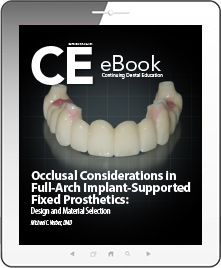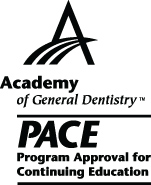CDEWorld > eBooks > Occlusal Considerations in Full-Arch Implant-Supported Fixed Prosthetics


ADA CERP is a service of the American Dental Association to assist dental professionals in identifying quality providers of continuing dental education. ADA CERP does not approve or endorse individual courses or instructors, nor does it imply acceptance of credit house by boards of dentistry. Concerns or complaints about a CE provider may be directed to the provider or to ADA CERP at www.ada.org/cerp/

Approved PACE Program Provider. FAGD/MAGD credit. Approval does not imply acceptance by a state or provincial board of dentistry, or AGD endorsement. 1/1/2023 to 12/31/2028. ID # 209722.
eBook
Released: Thursday, November 2, 2017
Expires: Tuesday, June 30, 2020
Occlusal Considerations in Full-Arch Implant-Supported Fixed Prosthetics
By Michael C. Verber, DMD
Commercial Supporter: Preat Corporation
Trading implants for teeth changes the masticatory system and its ability to mediate functional and parafunctional activity. Treatment requires careful consideration of prosthetic materials and design. This article will explore the differences between implants and teeth that expose implant prosthetics to unmitigated occlusal forces. The advantages and disadvantages of various prosthetic options and materials will also be discussed.
LEARNING OBJECTIVES:
-
Contrast occlusal considerations between implants and teeth.
-
Describe factors that influence prosthetic selection.
-
Recognize the advantages and disadvantages of various prosthetic materials.
-
Consider restorative options that facilitate management of prosthetic complications.
About the Author
Michael C. Verber, DMD, CEO & President, Verber Dental Group, Camp Hill, Pennsylvania
Download FREE eBook now!

